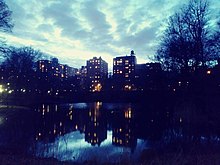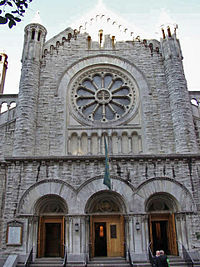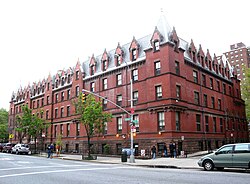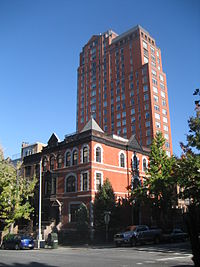Manhattan Valley
Manhattan Valley (also known as Bloomingdale
Geography
Manhattan Valley occupies a natural depression running east–west across Manhattan, declining rapidly from high rocky bluffs at the western border of Central Park, and following west the valley created by what was once a minor stream draining from roughly the area of the Harlem Meer into the Hudson River.[3] The area is located on a gentle slope between West 96th Street,[2][4] a major thoroughfare that runs in its own natural valley and stretches across town through Central Park,[4] and W. 110th Street.[4]
From west to east,

History
Development

Manhattan Valley was part of the Bloomingdale District, the name given to the farms and houses along the Bloomingdale Road along Manhattan's Upper West Side. The Dutch Bloemendaal was Anglicized to "Bloomingdale" or "the Bloomingdale District", for the west side of Manhattan from about 23rd Street up to the Hollow Way (modern 125th Street). It originally consisted of farms and villages along a road (regularized in 1703) known as the Bloomingdale Road. Bloomingdale Road was renamed The Boulevard in 1868, as the farms and villages were divided into building lots and absorbed into the city.[3][5]
By the 18th century it contained numerous farms and country residences of many of the city's well-off, a major parcel of which was the
In the early 1800s, John Clendening owned a farm that covered much of the valley, roughly from the Bloomingdale Road to 8th Avenue between 99th and 105th Streets, with a large mansion near Amsterdam and 104th Streets.[9][note 1] The area was known as the "Clendening Valley".[10] Although the Clendening estate was divided and sold in 1845,[11] the Clendening Valley name persisted until the 1880s, and a Clendening Hotel existed into the early 20th century.[11]
The construction of an elevated aqueduct to carry the
The area was populated mostly by
Later years

By the 1950s and 1960s, the area went into decline, in line with a trend of general urban deterioration in Manhattan.
The crime rate in the area increased dramatically, along with drug use and poverty.[20] By 1960, the Bloomingdale neighborhood had the highest juvenile-delinquency rate in Manhattan and the second-highest number of welfare cases per 1,000 residents.[21] New investment came to the area in the 1980s. Soon, however, new investment was brought to a halt by wavering property prices in the late 1980s and early 1990s, combined with the rise of crack use and dealers in the area, which gave Manhattan Valley the reputation as one of the easiest places in the city to score a hit.[22] In addition, there was a lot of violence on the streets of Manhattan Valley, especially at night, when gang wars were prevalent.[22]
With the Wall Street boom in the early 1980s, Manhattan as a whole experienced a sharp recovery. Seventy years after the Bloomingdale Asylum's closing, the provenance of the name was fading into obscurity, and residents and brokers alike began referring to the neighborhood by its present name.[23] The new name and recovery were both much bolstered by the non-profit Manhattan Valley Development Corporation (MVDC), founded in 1968. It sought to differentiate itself from other community-development organizations by opposing the demolition of pre-war buildings in favor of renovation and seeking to promote small business and "prevent harassment by out-side management companies prevalent in low income 'minority' neighborhoods."[24][22]
Gentrification

Manhattan Valley has gentrified significantly since the 1980s.[25] With this gentrification, rents in the area rose. The estimated population of Latino residents was fast dwindling by 1987.[16] Meanwhile, nonprofit groups started to renovate many structures that were owned by the city, as well as build housing on previously vacant tracts of land.[22] Reactions to this gentrification were mixed. In 1990, one resident stated, "The crime situation is our biggest threat ... but if we get rid of it, we're also faced with gentrification."[22] Coinciding with this gentrification in 1990, crime was declining steeply, although drug dealings were still common: one large drug arrest had been made in December of that year. The Frederick Douglass Houses, which had become frequented by drug dealers, was thought to be stymieing the development of new housing in the area, which included two apartment towers that had been constructed in the preceding two years.[22]
The Columbus Amsterdam business improvement district was organized in the late 1990s to develop stronger business presence along the main thoroughfares of Columbus and Amsterdam Avenues, and to provide entrepreneurial opportunities to locals.[26]
In 2005, brokers estimated that properties in the area were approximately 30% less expensive than comparable properties in the adjacent south.[27] The neighborhood's proximity to the much-valued Central Park as well as to three separate subway lines make it attractive to young commuters, and, as of 2006, prices were rising dramatically as New Yorkers were tipped off by their brokers.[25] Many historical brownstones and townhouses were saved from demolition, particularly east of Columbus Avenue, where the property values are the highest.[22] Yet the area remains diverse, representing a microcosm of the larger city in terms of the different ethnicities, ages and socioeconomic groups living within the same community.[17]
Demographics
According to the
Landmarks
This section needs expansion with: a listing of New York City designated landmarks. You can help by adding to it. (December 2019) |
- Frederick Douglass Circle, Central Park West and West 110th Street
- The former East River Savings Bank, which became the Aspirineum, housing a pharmacy, Amsterdam Avenue and West 96th Street[29]
- Church of the Ascension, West 107th Street between Broadway and Amsterdam Avenue
- Straus Park, Broadway and West 106th Street
- The former New York Cancer Hospital at 455 Central Park West between 105th and 106th streets.
Notable residents
- Ira Cohen, the poet, lived in an apartment at 106th Street and Broadway.[30][31]
- Barack Obama, the future U.S. president, rented an apartment at 142 West 109th Street, between Columbus Avenue and Amsterdam Avenue, while a student at Columbia University.[32][33]
The Central Park View

A plaque on the outside wall of the Central Park View, an apartment building at 415 Central Park West (at 101st Street), names the following as "people of note" who have lived there:
- Art Blakey
- Mary Colum
- Padraic Colum
- Marion Cumbo
- Yip Harburg
- Lorenz Hart
- Elvin Jones
- "Abby Lincoln" (Abbey Lincoln)
- Dwike Mitchell
- Joseph Papp
- Max Roach
- Teddy Wilson
Notes
- ^ As the farm was acquired prior to the introduction of the Commissioners' Plan of 1811, the boundaries of the farm did not line up precisely with the modern streets set up in the grid plan.
References
- ^ "Upper West Side History". Archived from the original on 2018-11-22. Retrieved 2018-11-18.
- ^ a b Zanoni, Carla (March 25, 2005). "Reactions Mixed as Businesses Close Along Broadway". Columbia Daily Spectator. Archived from the original on July 1, 2015. Retrieved 2010-07-18.
- ^ a b c "About the Neighborhood: Neighborhood History". Columbus Amsterdam Business Improvement District. Archived from the original on September 25, 2015. Retrieved 2010-10-02.
- ^ a b c "Manhattan Valley: What you might not know about the Upper West Side's neighbor to the north". BrickUnderground. 2013-07-23. Archived from the original on 2015-10-04. Retrieved 2015-10-16.
- ^ "Riverside-West 105th Street Historic District Designation Report" (PDF). New York City Landmarks Preservation Commission. April 19, 1973. Archived from the original (PDF) on March 4, 2016. Retrieved October 16, 2015.
- ISBN 978-1332169450.
- ISBN 978-0-89659-894-2.
- ^ Albrecht, Leslie (May 1, 2012). "From Bloomingdale to SoHa: One UWS Neighborhood's Quest for a Name". DNAinfo New York. Archived from the original on December 24, 2014. Retrieved October 16, 2015.
- ^ "West Side Lots At Auction for $9.50 In Clendening Estate Sale in 1845". The New York Times. December 3, 1911. Archived from the original on July 2, 2015. Retrieved October 16, 2015. (subscription required)
- ISBN 978-0-7385-6316-9. Retrieved October 17, 2015.
- ^ a b "John Clendening, Esquire, and his Bloomingdale Estate". bloomingdale history. October 9, 2015. Archived from the original on October 10, 2015. Retrieved October 17, 2015.
- ^ a b c d "Manhattan Avenue Historic District Designation Report" (PDF). May 15, 2007. New York City Landmarks Preservation Commission. Archived (PDF) from the original on March 17, 2016. Retrieved October 16, 2015.
- ISBN 978-0943651255.
- ^ Mann, Maurice (March 23, 2005). "Get Ahead of the Crowd in Manhattan Valley". Real Estate Weekly. Archived from the original on May 24, 2013. Retrieved July 18, 2010.
- ^ Barbanel, Josh (September 17, 2006). "Would an Aardvark Live Here?". The New York Times. Archived from the original on July 1, 2017. Retrieved July 18, 2010.
- ^ a b Berger, Joseph (September 11, 1987). "HISPANIC LIFE DIMS IN MANHATTAN VALLEY". The New York Times. Archived from the original on March 9, 2016. Retrieved October 17, 2015.
- ^ a b c d "Manhattan Valley: A Community Vision for the Future" (PDF). Pratt Institute Graduate Department of City & Regional Planning. May 18, 2010. Archived (PDF) from the original on April 6, 2013. Retrieved October 16, 2015.
- ^ a b "West 100th St.: Prosperity Ends and Crime Begins". The New York Times. July 22, 1986. p. A24. Archived from the original on March 14, 2018. Retrieved January 10, 2015.
- ^ "PLAN BOARD BACKS DOUGLASS HOUSES; Huge Manhattantown Project Opposed by Area Residents as Too Costly for Them". The New York Times. February 7, 1952. Archived from the original on April 5, 2017. Retrieved October 17, 2015.(subscription required)
- ^ Goodman Jr., George (November 26, 1972). "West 100th St.: Prosperity Ends and Crime Begins". The New York Times. p. D84. Archived from the original on March 14, 2018. Retrieved January 10, 2015.
- ^ "Where The Need Is Greatest". The New York Times. October 27, 1963. p. 405.
- ^ a b c d e f g Nieves, Evelyn (December 25, 1990). "Manhattan Valley's Long Awaited Boom Ends Up Just a Fizzle". The New York Times. Archived from the original on August 25, 2023. Retrieved July 18, 2010.
- ^ Steele, Lockhart (April 3, 2006). "Manhattan Valley, Insane or Not?". NY.Curbed.com. Archived from the original on August 26, 2016. Retrieved October 16, 2015.
- ^ "History". Manhattan Valley Development Corporation. Archived from the original on October 8, 2007. Retrieved October 16, 2015.
- ^ AM New York. Archived from the originalon May 26, 2008.
- ^ "District Map, Mission Statement, Meeting Minutes: Mission". Columbus Amsterdam Business Improvement District. Archived from the original on April 11, 2020. Retrieved April 10, 2020.
- ^ Robledo, S.Jhoanna (February 21, 2005). "Valley of the Deals". New York. Archived from the original on July 1, 2015. Retrieved July 18, 2010.
- ^ "Demographic/Catchment Area". Manhattan Valley Development Corporation. Archived from the original on January 6, 2009.
- ^ Hughes, C.J. (2005-02-06). "From the Outside, They Still Look Like Banks". The New York Times. Archived from the original on 2021-05-06. Retrieved 2015-10-17.
- ^ Gaddy, James (27 August 2006). "Long, Strange Trip for a Hypnotic Film - The New York Times". The New York Times. Archived from the original on 2 December 2021. Retrieved 2 December 2021.
- ^ "Lower East Side Biography Project - Stemming the Tide of Cultural Amnesia, New York, NY (2022)". Archived from the original on 2021-12-02. Retrieved 2021-12-02.
- ISBN 978-1-4000-4360-6.
- ^ Smith, Elizabeth A. (June 7, 2010). "Bragging Rights: President Obama Studied Here". The New York Times. Archived from the original on 2014-08-26. Retrieved 2010-07-18.
